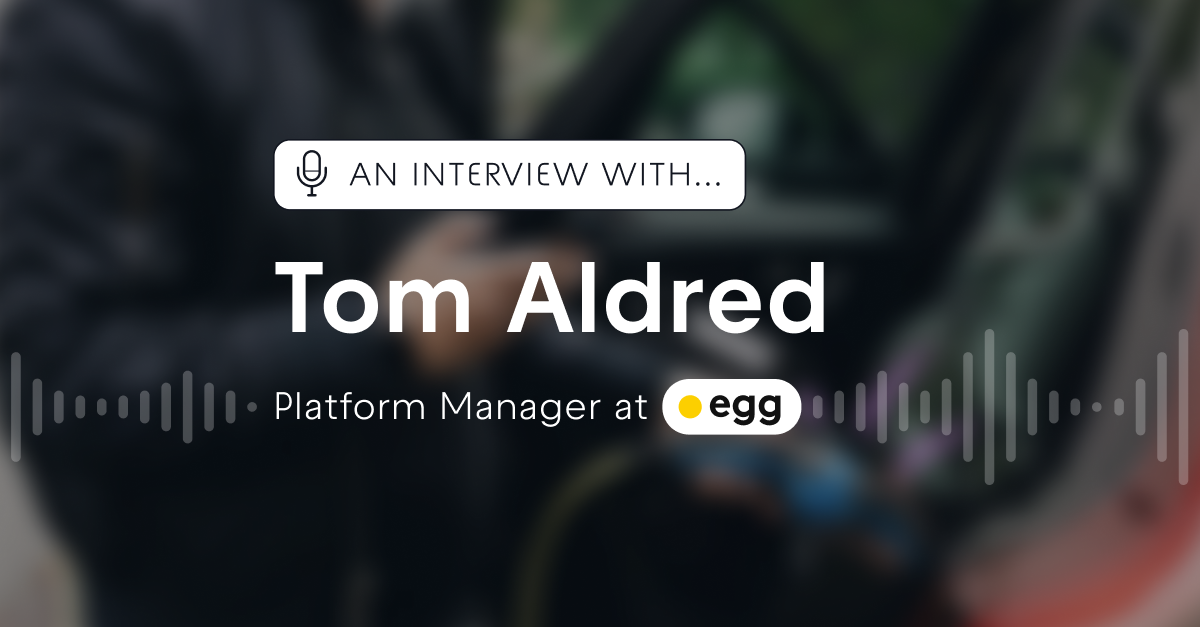
We recently sat down with Tom Aldred, Platform Manager at egg, to talk about his job managing and monitoring 200 chargers across the United Kingdom. Previously known as The Phoenix Works, egg provides sustainable turnkey EV charging, solar, and battery solutions for the residential, business and public sectors. Having spent the last 11 years helping build up the UK’s EV charging infrastructure, the company carries deep operational know-how to keep drivers on their electric journey.
Many of our partners entered the industry with a passion to transform EV charging. Tom, how was it for you? What is the biggest driver in your work?
It might be a cliche, but I really care about improving the driver experience. I’ve driven an EV for a couple of months now and considering that I work in this industry, the user experience needs to get better. You can go to any charger around the UK, and it will offer a completely different experience every time. That is why I want to keep on learning more about the EV industry and what we at egg can do to improve the space for drivers.
Driving an EV should be as easy as any petrol car (if not easier!). That’s why egg invests in holistic charging solutions so it’s super easy for drivers to get started. We know the charging ecosystem can be confusing for newcomers, so we are actively introducing contactless payment options at our public chargers. At the same time, we are doing our best to address climate change by tailoring solutions to client requirements with a full portfolio of inter-connecting green technology to make sustainable mobility and living possible.
What does that translate into for your day-to-day work?
A big part of my day revolves around monitoring our live chargers, checking in on any that became faulty, and mobilizing engineers where required based on information we gather.
The Plugsurfing Power Platform is our main tool for monitoring the real-time health and performance of chargers, and it is one of many tabs in my browser that I keep open all day long. It gives me a good overview of the live situation. I can check the status of any charger and get all the details I need to see what might be happening.
What kind of data do you track?
We look at the charger uptime, number of offline chargers, and chargers in fault. Regular updates help us identify which chargers are consistently having problems and display certain behavioural patterns, which means we can proactively address things as they arise, rather than waiting to be informed about it by a customer.
We also check on energy efficiency, for example to know how much energy is being provided to the vehicles and the revenue that comes from the charging sessions. In the future, we hope to include a carbon footprint in the mix.
What happens if you see one of your chargers malfunctioning?
When I spot a faulty charger, I run a quick check through OCPP (Open Charge Point Protocol) and event log and then jump directly into the charger’s configuration via its web server. Charger visibility in the platform is important because it is quite common for SIM chargers to go offline for a couple of minutes, especially in areas with low reception.
To make sure we will not miss anything important, we set up alerts that will notify us if a charger has been inactive for 24 hours. Using Plugsurfing’s error management we can create unique triggers for charger type or status. Automatic alerts like these give both us and our customers peace of mind knowing that we can catch issues before the drivers arrive.
What about getting new chargers up and running?
We add about 20 chargers per month. I will need to add and configure them onto the platform, so a bulk upload is a huge time saver. I collect charger information on an ongoing basis, so when they are ready, all I need is to create a template for each charger model and start the upload. Once the charger is connected to the platform, I configure connector and customer groups and set up pricing profiles.
The ability to set up special access and pricing is especially important in hybrid use cases. We have customers who offer workplace chargers, where they want to be able to provide different pricing for the staff, the company fleet, and those not associated with the workplace. In the Plugsurfing Power Platform, we can add the chargers to the right connector groups and create customer groups for each group, for example employees, fleet, and everyone else, and assign different prices to all.
Apart from creating special pricing for certain groups, price profiles give us the ability to attribute many factors to the price. Our customers can apply a flat fee or decide to offer cheaper charging at night when electricity prices are lower.
Do you encourage your business customers to use the Plugsurfing Power Platform?
The platform is extremely user-friendly, so it makes it much easier to get newcomers comfortable with day-to-day use of the software without scaring them away! I will usually give clients a short onboarding after which they can get started right away.
Not everything can be outsourced, and many clients don’t have the time or the desire to do a deep dive into all things EV. Therefore, being able to give our clients the comfort of knowing we can provide them with all the data they need as the Charge Point Operators with strong knowledge of this platform eco-system instills both confidence in us as a provider and P3 as the right SaaS solution. I often work on reporting and reconciliation for our clients. Luckily, I can get all the information I need out of the platform, including time-saving reports on charging sessions and paid transactions.
What type of customers do you often work with?
We have a wide variety of customers that include fleets, housing associations, and a handful of public chargers. In the future, we might start offering a sub-CPO proposition, where we will resell the Plugsurfing Power Platform to other charging point operators in our market.
Tom, you have mentioned at the beginning of our chat that your goal is to make charging easier for the drivers. How do you think the industry will change in the next five years?
EV charging should be so easy that anyone can plug in and charge without worrying about compatible apps and charging keys. That’s why I see the new standard for charging, Plug & Charge, as a huge step in the right direction.
We still have a long way to go. There is a lot of fragmentation in the market as companies use a patchwork of technologies and approaches.
We need to get to a place where new EV drivers are telling their friends and family about how easy it all is, rather than recounting horror stories to their EV driving pals about the time they got stuck at a motorway service!
The EV charging industry has a very bright future and an amazing opportunity to make big changes. What we need now, is the will and determination to join forces nationally and globally across the industry to encourage the uptake of EVs and renewables. I believe that a combined effort of the key players will drive innovation and encourage the governments to step in. If we all work together, we have a chance to decarbonize the economy and possibly mitigate climate change.
It’s not the answer to everything, but it’s one small piece of a much bigger picture that will drive us in the right direction overall.

